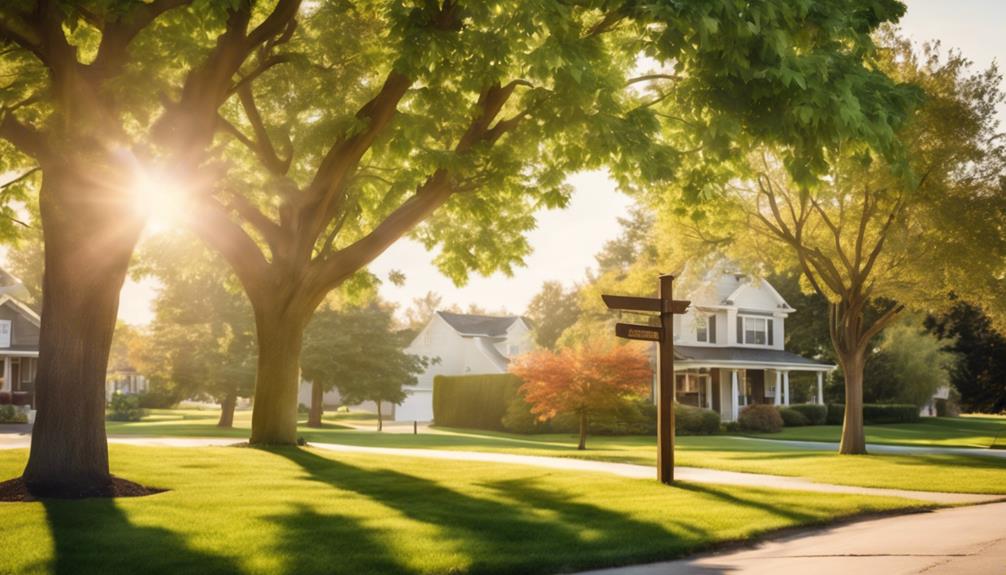
Why Choose Professional Garden Cleanup Services?
20 March 2025Why Choose Eco-friendly Hedge Trimming Services?
20 March 2025Urban areas demand specialised tree care services to support eco-friendly green spaces.
The best services focus on tree health, soil quality, and sustainable practices. Key offerings include thorough initial tree assessments, tailored pruning, and effective pest management strategies.
Environmentally responsible methods are crucial for improving air quality and promoting biodiversity. Reliable providers like TKL Birmingham Gardener utilise certified arborists for extensive care.
They customise their services to meet the unique challenges of urban environments, ensuring ideal growth and resilience.
Exploring effective approaches will reveal more options for maintaining urban greenery and enhancing community well-being.
Urban Tree Health Essentials
Maintaining urban tree health is essential for the sustainability of city ecosystems.
Key factors include effective soil quality management, which supports root development and nutrient uptake, along with the implementation of proper pruning techniques to improve tree structure and growth.
Together, these practices ensure the vigour and longevity of urban trees, contributing to enhanced environmental quality and urban aesthetics.
Soil Quality Management
How can soil quality greatly influence the health of urban trees?
Soil serves as the foundation for tree vitality, impacting nutrient availability, water retention, and root development. Urban environments often feature compacted, contaminated, or poor-quality soils, which can impede tree growth and resilience.
Crucial elements such as organic matter, pH balance, and microbial activity must be carefully managed to foster ideal conditions for urban trees. Regular soil assessments and amendments, such as the incorporation of compost and mulch, can improve soil structure and fertility.
Furthermore, implementing effective drainage solutions can prevent waterlogging, which is detrimental to root health. By prioritising soil quality management, urban tree care services can ensure sustainable growth and longevity of tree populations in metropolitan landscapes.
Pruning Techniques Importance
Effective pruning techniques play an important role in promoting urban tree health and longevity. Pruning not only improves the structural integrity of trees but also facilitates ideal light penetration and air circulation, which are critical for photosynthesis and growth.
When executed properly, these techniques mitigate the risk of disease by removing dead or diseased branches, thereby preventing the spread of pathogens. Furthermore, strategic pruning encourages desirable branching patterns, enhancing both aesthetics and stability.
It is imperative to adhere to species-specific guidelines to avoid unnecessary stress or damage. Ultimately, mastering pruning techniques is fundamental for urban arborists and tree care professionals, ensuring that trees thrive in often challenging urban environments while contributing to biodiversity and ecological balance.
Soil Quality and Composition
Soil quality and composition play a critical role in the overall health of urban trees.
Key factors such as nutrient availability, water retention capacity, and microbial activity significantly influence tree growth and resilience.
Understanding these components is vital for implementing effective tree care strategies in urban environments.
Nutrient Availability in Soil
A healthy urban tree thrives on the availability of critical nutrients in the soil, which greatly influences its growth and overall vigour. Soil nutrient availability is vital for tree health, as deficiencies can lead to stunted growth and increased susceptibility to disease.
Key factors affecting nutrient availability include:
- Soil pH: The acidity or alkalinity of the soil directly impacts nutrient solubility and uptake efficiency.
- Organic Matter: Decomposed materials improve nutrient retention and provide a reservoir of essential elements.
- Microbial Activity: Beneficial soil microbes facilitate nutrient cycling and enhance soil structure.
Understanding these elements allows tree care professionals to implement effective strategies for improving soil health, ensuring urban trees receive the nutrients necessary for robust growth and longevity.
Water Retention Capacity
Nutrient availability in the soil is intricately linked to the water retention capacity, as both factors greatly influence tree health and growth in urban environments.
Effective management of soil quality is crucial for optimising water retention, which can considerably mitigate stress on urban trees.
Key factors contributing to water retention include:
- Soil texture: The proportion of sand, silt, and clay determines the soil's ability to hold moisture.
- Organic matter: Decomposed plant material improves both water retention and nutrient availability.
- Soil compaction: Reduced porosity from compaction hinders water infiltration and retention, adversely affecting root systems.
Microbial Activity in Soil
Microbial activity in soil plays a fundamental role in determining its quality and composition, greatly influencing tree health in urban areas. The diversity and abundance of soil microbes are critical for nutrient cycling, organic matter decomposition, and the general vitality of urban ecosystems.
Key contributions of microbial activity include:
- Nutrient Availability: Microbes facilitate the breakdown of organic materials, releasing essential nutrients for trees.
- Soil Structure: Microbial exudates improve soil aggregation, enhancing aeration and water infiltration, which are vital in compacted urban soils.
- Disease Suppression: Beneficial microbes can deter pathogens, reducing the incidence of tree diseases and promoting resilience.
Understanding and promoting microbial activity can significantly improve urban tree care, ensuring robust growth and longevity in challenging environments.
Initial Assessment of Trees
The initial assessment of trees is essential for effective urban tree care, encompassing tree species identification, regular pruning techniques, and tree canopy management strategies.
Accurate identification allows for tailored care specific to each species, while appropriate pruning promotes healthy growth and aesthetics.
Moreover, effective canopy management ensures that trees thrive in their urban environment, enhancing both biodiversity and community well-being.
Tree Species Identification
Accurate tree species identification is a crucial component of effective urban tree care management. Proper identification enables arborists to tailor care strategies that align with the specific needs of each species, enhancing longevity and vitality.
A systematic approach to identification involves:
- Evaluating morphological characteristics, such as leaf shape and bark texture.
- Considering the tree's growth habit and overall structure.
- Examining the local ecosystem, including soil type and climatic conditions.
Understanding these elements fosters informed decision-making regarding planting, maintenance, and potential pest management.
By mastering tree species identification, urban foresters can implement targeted interventions that promote healthy urban forests, ultimately benefiting both the environment and community aesthetics.
This foundational skill is essential in cultivating resilience within urban tree landscapes.
Regular Pruning Techniques
In urban tree care, regular pruning is essential for maintaining tree health and aesthetics. An initial evaluation of trees ensures that pruning techniques are effectively tailored to each specimen's needs. This analysis allows arborists to identify structural issues, the presence of disease, and growth patterns, facilitating informed decision-making.
Key components of the initial evaluation include:
- Evaluating tree structure: Analysing branch angles and weight distribution to improve stability.
- Identifying dead or diseased wood: Removing compromised branches to prevent further decay and pest infestations.
- Understanding growth habits: Recognising species-specific growth patterns to guide appropriate pruning techniques.
Tree Canopy Management Strategies
Effectively managing tree canopies requires a thorough initial evaluation to ensure optimal growth and health in urban environments.
This evaluation serves as the foundation for informed management strategies that enhance both ecological and aesthetic values.
Key components of the initial evaluation include:
- Species Identification: Understanding the specific needs and growth patterns of each tree species aids in providing tailored care.
- Health Evaluation: Analysing the general health of trees, including signs of disease or pest infestations, informs necessary interventions.
- Canopy Structure Analysis: Reviewing the tree canopy's structure and density assists in planning pruning and maintenance to optimise light penetration and air circulation.
These strategies ensure that urban tree canopies thrive, significantly contributing to the urban ecosystem.
Improved Urban Air Quality
Urban areas often experience significant air pollution due to factors such as vehicle emissions and industrial activities. The integration of trees within urban environments plays an essential role in mitigating these effects. Trees actively absorb pollutants, such as sulphur dioxide, nitrogen oxides, and particulate matter, while also releasing oxygen through photosynthesis.
| Benefits of Urban Trees | Mechanisms |
|---|---|
| Improved Air Quality | Absorption of harmful pollutants |
| Temperature Regulation | Shade provision and transpiration |
| Biodiversity Improvement | Habitat creation for diverse species |
Sustainable Pest Management Techniques
Sustainable pest management techniques are crucial for maintaining the health of urban trees while minimising environmental impact.
Methods such as organic insecticidal soap application, beneficial nematode treatment, and the strategic release of beneficial insects provide effective alternatives to traditional chemical pesticides.
Implementing these practices not only protects urban flora but also promotes a balanced ecosystem within city landscapes.
Organic Insecticidal Soap Application
Organic insecticidal soap serves as an effective tool in the arsenal of pest management for urban landscapes, providing a non-toxic solution to combat common garden pests.
This biodegradable remedy targets soft-bodied insects, such as aphids, spider mites, and whiteflies, without harming beneficial organisms.
Key benefits of organic insecticidal soap include:
- Minimal environmental impact: Formulated from natural plant oils and fats, it poses no threat to wildlife or water sources.
- Fast-acting efficacy: The soap disrupts the cellular structure of pests upon contact, leading to rapid elimination.
- Ease of application: Its user-friendly nature allows for straightforward application via spray, ensuring thorough coverage on affected plants.
Beneficial Nematodes Treatment
Beneficial nematodes, microscopic roundworms that naturally inhabit soil, are a powerful yet environmentally friendly solution for managing pest populations in urban gardens.
These organisms target specific soil-dwelling pests, such as grubs and larvae, effectively disrupting their life cycles without harming beneficial insects or plants.
- They are easy to apply and integrate seamlessly into existing pest management programmes.
- Beneficial nematodes thrive in different environmental conditions, making them versatile for urban landscapes.
- Their reproductive capabilities guarantee ongoing pest suppression, enhancing long-term plant health.
Beneficial Insect Release Strategy
In urban landscapes, the strategic release of beneficial insects serves as an effective approach to pest management, promoting ecological balance while minimising chemical interventions.
This technique harnesses the natural predatory behaviours of insects to control pest populations, ensuring a healthier urban ecosystem.
Implementing this strategy involves:
- Identifying pest species: Accurate identification allows for targeted release of specific beneficial insects.
- Timing and environment: Releasing insects during ideal conditions improves their effectiveness and survival rates.
- Monitoring and assessment: Regular evaluation of pest and beneficial insect populations helps refine the strategy for ongoing success.
Urban Wildlife Interactions
Urban wildlife interactions are increasingly influenced by the presence of invasive species, which can disrupt local ecosystems and threaten native wildlife.
Effective management techniques are crucial for maintaining biodiversity, whilst community engagement initiatives and tree planting programmes foster a harmonious coexistence between urban residents and wildlife.
Invasive Species Management Techniques
Effective management of invasive species in urban environments is vital for maintaining a balanced ecosystem and protecting native wildlife.
Implementing strategic techniques can mitigate the detrimental effects these species have on biodiversity.
- Early Detection and Rapid Response: Identifying invasive species promptly allows for effective removal before they establish dominance.
- Ecological Restoration: Revitalising native habitats can help restore ecological balance and resilience against invasives.
- Public Education and Training: Engaging the community in understanding invasive species fosters a culture of vigilance and proactive management.
Community Engagement Initiatives
Fostering community engagement initiatives around urban wildlife interactions is essential for enhancing biodiversity and promoting coexistence.
These initiatives not only educate residents about the significance of local wildlife but also empower them to take an active role in conservation efforts.
Effective strategies include:
- Workshops and Educational Programmes: Providing information on local species and their ecological roles fosters appreciation and understanding.
- Wildlife Observation Days: Organising events that encourage residents to observe and document urban wildlife helps build community interest and stewardship.
- Citizen Science Projects: Involving the community in data collection can improve research efforts while promoting a sense of ownership over local ecosystems.
Community Tree Planting Programs
While enhancing urban landscapes, community tree planting programmes play an important role in supporting local wildlife interactions.
These initiatives foster biodiversity by creating habitats that are significant for numerous species. The integration of trees within urban environments not only beautifies the area but also provides important resources for wildlife.
- Nesting Sites: Trees offer safe locations for birds and other animals to build nests, promoting reproductive success.
- Food Sources: Fruit-bearing and flowering trees attract pollinators and provide sustenance for local fauna, enhancing the ecological balance.
- Corridors for Movement: Tree canopies facilitate safe passage for small mammals and insects, encouraging genetic diversity through interconnectivity.
Ultimately, community tree planting programmes are fundamental for nurturing vibrant ecosystems in urban settings.
Why Choose TKL Birmingham Gardener
Choosing TKL Birmingham Gardener for your tree care needs guarantees a commitment to excellence and reliability that sets us apart in urban forestry.
Our team consists of certified arborists and horticulturists, equipped with the latest techniques and tools to ensure optimal care for your trees. We recognise the unique challenges posed by urban environments and tailor our services to meet these specific needs.
Our comprehensive approach includes risk assessment, pruning, disease management, and sustainable planting practices. Furthermore, we prioritise environmentally responsible methods, minimising our ecological footprint while enhancing urban green spaces.
With a reputation built on trust and professionalism, TKL Birmingham Gardener is your partner in maintaining the health and beauty of your trees, contributing to a vibrant urban ecosystem.
Common Tree Care Questions
Tree care often raises a variety of questions among property owners and urban residents. One common inquiry pertains to the best species for urban environments, as factors such as pollution and limited space considerably influence tree selection.
Moreover, many wonder about the proper techniques for pruning and maintaining tree health, emphasising the importance of understanding seasonal growth patterns. Questions regarding pest management and disease prevention are also prevalent, highlighting the need for integrated pest management strategies specific to urban flora.
In addition, property owners frequently seek guidance on tree planting locations to ensure ideal sunlight and soil conditions. Addressing these concerns through expert advice fosters healthier urban trees, ultimately enhancing the community's green spaces and ecological balance.
Tree Care Maintenance Schedule
A well-structured maintenance schedule is vital for promoting the health and longevity of urban trees. Regular care ensures that trees flourish amidst the challenges of urban environments, such as limited space and pollution.
A comprehensive schedule typically encompasses several key activities:
- Pruning: Conduct routine pruning to remove dead or diseased branches and shape the canopy for optimal growth.
- Fertilisation: Apply appropriate fertilisers based on soil tests to provide necessary nutrients during the growing season.
- Pest Management: Monitor for pests and diseases, implementing integrated pest management strategies as necessary.




